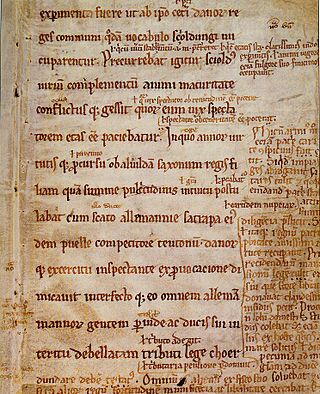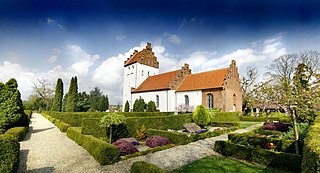This is a list of chronicles, annals and historical works about Denmark from antiquity to medieval times. These books / writings (and others), which were mostly written in Latin, form the bases of knowledge for the early history of Denmark.
This is a list of chronicles, annals and historical works about Denmark from antiquity to medieval times. These books / writings (and others), which were mostly written in Latin, form the bases of knowledge for the early history of Denmark.

Gesta Danorum is a patriotic work of Danish history, by the 12th-century author Saxo Grammaticus. It is the most ambitious literary undertaking of medieval Denmark and is an essential source for the nation's early history. It is also one of the oldest known written documents about the history of Estonia and Latvia.

Harald "Bluetooth" Gormsson was a king of Denmark and Norway.

Ubba was a 9th-century Viking and one of the commanders of the Great Heathen Army that invaded Anglo-Saxon England in the 860s. The Great Army appears to have been a coalition of warbands drawn from Scandinavia, Ireland, the Irish Sea region and Continental Europe. There is reason to suspect that a proportion of the Viking forces specifically originated in Frisia, where some Viking commanders are known to have held fiefdoms on behalf of the Franks. Some sources describe Ubba as dux of the Frisians, which could be evidence that he also associated with a Frisian benefice.
Danske Lov is the title of a Danish statute book from 1683 that previously formed the basis for the Danish legislation. Even though it was mainly a compilation of older, regional laws, it took seven different commissions over several decades under two different monarchs to put the Code together. In 1687, Norway received its Norwegian Code, which in form and content is about identical to the Danish Code. The Danish Code has been translated into English, Latin, German and Russian.

Skjalm Hvide, was the Earl of Zealand in Denmark in the end of the Viking Age (793–1066) and up to his death. Skjalm's father was Toke Trylle, whose father was Slag, based on Absalon, a medieval account scanned, translated and published by Google.
Petrus Olai was a Danish Franciscan friar and historiographer. No details about his life are known. He refers to himself as Petro Olavo Saneropio Minoritano in a colophon of his Collectanea ad historiam danicam pertinentia. A later note in the same manuscript by Anders Sørensen Vedel suggests that he was dead by c. 1570.
This chronology presents the timeline of the Crusades from the beginning of the First Crusade in 1095 to the fall of Jerusalem in 1187. This is keyed towards the major events of the Crusades to the Holy Land, but also includes those of the Reconquista and Northern Crusades as well as the Byzantine-Seljuk wars.
Gesta Danorum, called Gesta Danorum på danskæ to distinguish it from the better known Gesta Danorum by Saxo Grammaticus, is a Danish historical chronicle written in Old Danish in Lund around the year 1300.